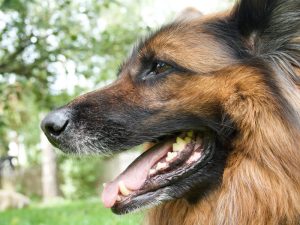Caring for your pet’s teeth may require anesthesia
 CONTRA COSTA COUNTY, CA (Nov. 13, 2024) — It is easy to take our pets’ dental health for granted. When dogs and cats are young, we don’t see buildup of plaque and its eventual end-product of tartar (calculus), which is basically calcified bacteria on their teeth.
CONTRA COSTA COUNTY, CA (Nov. 13, 2024) — It is easy to take our pets’ dental health for granted. When dogs and cats are young, we don’t see buildup of plaque and its eventual end-product of tartar (calculus), which is basically calcified bacteria on their teeth.
Since your pet isn’t regularly brushing its teeth like we do, of course, there is no way to prevent this from occurring over time. Way back when your pet was a baby, you might have been instructed to get them used to allowing you to brush their teeth. But then, it was important that you actually brushed those teeth regularly, whether with a soft children’s toothbrush or a pet toothbrush (like a finger puppet with a brush at the end). You can also purchase dental wipes that help remove plaque before it solidifies as calculus on their teeth.
Another concern is retained deciduous canine teeth in puppies, which can prevent adult canine teeth from coming in at the correct angle. In this scenario, the adult canine (fang) tooth doesn’t push the baby canine tooth out of the way to cause it to fall out naturally, so they look a little like a baby shark with two “rows” of canine teeth.
I recommend removing these cute, very sharp baby canines so the adult canine tooth can come in and land in the right place.
Fractures

Fractured teeth are another problem in veterinary dental health. Dogs, in particular, love to chew, and oftentimes they chew hard substances like bone, antler and other hard toys. Fractured teeth can lead to tooth root abscesses and exposed nerve roots, both of which can be quite painful and unhealthy for your pet. Swelling under one eye is often an indicator of a tooth root abscess in a molar or premolar.
Sometimes it is hard to pinpoint periodontal (dental) disease as a cause of your pet’s discomfort. You might notice bad breath or see them chewing on one side of their mouth if they have a sore tooth. You could even see a little blood on food and toys or in their water bowl. Changes in appetite and weight can also be an indicator.
An awake oral exam may not clearly show your veterinarian the problem, so your vet must sometimes back into the suspicion of periodontal pain and disease after ruling out other issues. Periodontal disease can even lead to health problems with the heart, kidneys and other organs, especially as our pets age.
Anesthesia
Not surprisingly, there comes a time in most dogs’ and cats’ lives that they will require a periodontal cleaning with anesthesia. Generally, our pets will not safely allow an awake exam and cleaning that gets under the gum tissue. Under anesthesia, the vet can also gently probe to see if they have pockets of decay around the teeth.
It is easy to miss important dental disease without anesthesia. Under anesthesia, your veterinarian can also take dental radiographs (X-rays) and perform safe and comfortable cleaning and probing around all your pet’s teeth. For more advanced dental work, board-certified veterinary dentists have a higher expertise for root canals, pulpotomies and other procedures that might help in more severe situations.
Anesthesia is its own issue, especially as our pets age and have other illnesses that might make anesthesia riskier than in a young, otherwise healthy animal. Anesthesia requires monitoring by a skilled staff, and your veterinary office should be well trained in this area.
Bottom line, dental disease is easy to overlook and taking care of your pet’s teeth should not take a back seat in their overall care. Your pet will thank you for it.
Check with your veterinarian or research online at places like www.avma.org/resources-tools/pet-owners/petcare/pet-dental-care.
Email questions and comments to drmccabevet@gmail.com.

Micki McCabe
Micki McCabe Walls, DVM, DACVIM, FAAVA, is a long-time Clayton resident. The recently retired local veterinarian has an interest in internal and integrative medicine.
